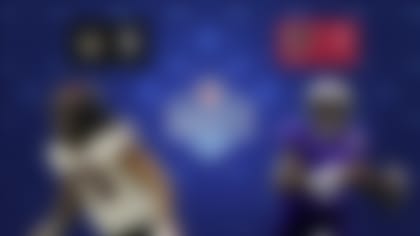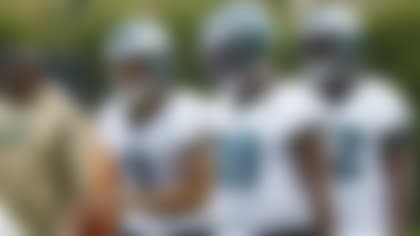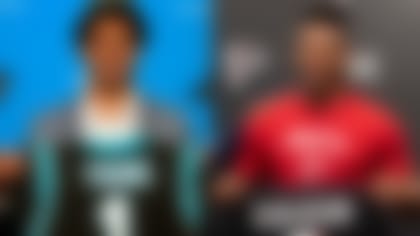Why provide instant grades on the selections of prospects who have yet to take an NFL snap? Well, you're reading this, aren't you? Considering the makeup of every roster and the factors surrounding each pick, Gennaro Filice and Dan Parr attempt a division-by-division assessment of the 2022 NFL Draft. Keep in mind that these grades are based on draft hauls alone -- picks traded for veteran players were not taken into account. Below is Gennaro's NFC South report card.
NOTE: Draft classes are displayed from best to worst within the division.
Round 1:
- (No. 8) Drake London, WR, USC
Round 2:
- (38) Arnold Ebiketie, Edge, Penn State
- (58) Troy Andersen, LB, Montana State
Round 3:
- (74) Desmond Ridder, QB, Cincinnati
- (82) DeAngelo Malone, Edge, Western Kentucky
Round 5:
- (151) Tyler Allgeier, RB, BYU
Round 6:
- (190) Justin Shaffer, OG, Georgia
- (213) John FitzPatrick, TE, Georgia
March was a tough month for the Falcons. First, WR1 Calvin Ridley was suspended through at least the 2022 season for betting on NFL games. Then WR2 Russell Gage and LB Foye Oluokun -- a pair of sixth-round picks from the 2018 draft who blossomed into key cogs in Atlanta -- cashed in elsewhere in free agency, with Gage joining the rival Buccaneers. And the final blow: After the failed public pursuit of Deshaun Watson understandably alienated 14-year franchise face Matt Ryan, the Falcons traded the former league MVP for a third-round pick. With all of that coming on the heels of a fourth straight losing season, it felt like bottom for the franchise, suddenly featuring one of the most talent-poor rosters in the league. But nothing lifts NFL spirits like a well-executed draft -- and at least according to this grader, that's exactly what second-year GM Terry Fontenot provided. Entering last Thursday with a receiving corps headlined by Olamide Zaccheaus and Auden Tate, Atlanta sensibly took the first dip in the WR prospect pool, snatching up London. Combining the 6-foot-4, 219-pounder with 6-6, 245-pound Kyle Pitts is either exhilarating or terrifying, depending on your rooting interests. In Round 2, Fontenot jumped up five spots to address another crying need, adding Ebiketie to a pass rush that finished dead last in QB pressures and sacks in 2021. In fact, with just 18 sacks in 17 games, Atlanta had 11 fewer than any other team. No wonder the Falcons doubled down on edge rushers, taking Malone with their second pick of Round 3. Of course, their first pick of that round stole all the headlines, as Atlanta became just the second team to take a quarterback in this draft. A four-year starter with a 43-6 record at Cincinnati, Ridder lifted the program to unprecedented heights. While there are concerns about the athletic quarterback's accuracy, no one questions his intangibles and leadership skills. Throughout the pre-draft process, team evaluators fell all over themselves praising Ridder's beyond-his-years maturity and ability to command the room. As reported by colleague Cameron Wolfe, head coach Arthur Smith expects free-agent signee Marcus Mariota to open the season as the starter, but Ridder could push for playing time as the season goes on. Lastly, quick shout-out to Andersen, a mega athlete who starred at Montana State as a quarterback and running back in his first two seasons, before fully concentrating on linebacker and becoming the Big Sky Defensive Player of the Year. Just a fun prospect. Oh, and at the NFL Scouting Combine, he blazed a 4.42 40-yard dash at 243 pounds.
Round 1:
- (No. 6) Ickey Ekwonu, OT, N.C. State
Round 3:
- (94) Matt Corral, QB, Mississippi
Round 4:
- (120) Brandon Smith, LB, Penn State
Round 6:
- (189) Amare Barno, Edge, Virginia Tech
- (199) Cade Mays, OG, Tennessee
Round 7:
- (242) Kalon Barnes, CB, Baylor
Going back to his college days at Baylor and Temple, Matt Rhule has always bet big on traits. And when those traits intersect with value and need, that's a formula for success. Despite entering draft weekend with just six selections, including only one in the first three rounds, Carolina left with four prospects ranked in Daniel Jeremiah's top 140. Of course, it helps when the board falls your way like it did for the Panthers, starting with their very first selection. Coming into Thursday night, there was some question as to whether any of the top three offensive tackles would be still be available at No. 6 overall. As it turned out, Carolina had its pick of the litter, and the Panthers pounced on the Charlotte native. Ekwonu's game still needs some polish, particularly in pass pro, but the explosive tools are plain to see in the O-line porn that is his highlight reel. The only real downside to taking the tackle in Round 1 was the widespread perception that it'd prevent the QB-needy Panthers from scoring a signal-caller who could push Sam Darnold for snaps. But the board again fell in Carolina's favor, with the bottom falling out of the draft's QB market after Kenny Pickett's first-round selection. The Panthers traded into Round 3 and stopped Corral's slide at No. 94. While the Ole Miss product is a polarizing eval, on and off the field, he offers plus athleticism and the quickest release in this class. Darnold remains the incumbent starter, but Corral's simple presence on the roster makes this team more interesting. On Day 3, Carolina went FULL RHULE, collecting three freak athletes in Smith, Barno and Barnes, the last of whom ran the second-fastest 40-yard dash in combine history (4.23).
Round 2:
- (No. 33) Logan Hall, DL, Houston
- (57) Luke Goedeke, OG, Central Michigan
Round 3:
- (91) Rachaad White, RB, Arizona State
Round 4:
- (106) Cade Otton, TE, Washington
- (133) Jake Camarda, P, Georgia
Round 5:
- (157) Zyon McCollum, CB, Sam Houston State
Round 6:
- (218) Ko Kieft, TE, Minnesota
Round 7:
- (248) Andre Anthony, Edge, LSU
With a championship-caliber roster devoid of many pronounced needs, the Buccaneers immediately addressed the two softest spots with their first two picks. With Ndamukong Suh's contract up, Tampa had an opening on the defensive front. Tossing the high-cut Hall next to beefy bull rusher Vita Vea makes for an intriguing arrangement, as the Houston product's more of a quick, agile disruptor with a toolbox full of pass-rushing maneuvers. Hall generated plenty of first-round buzz in recent months, ultimately just missing out as the opening selection of Round 2. Twenty-four picks later, Jason Licht went fishing for a left guard to replace suprise retiree Ali Marpet. A former tight end who played offensive tackle at Central Michigan, Goedeke is a projection as an NFL guard, but he seems to have the right demeanor for interior trench warfare: "I'm a nasty guy," the former Chippewa told the Detroit Free Press. "Like, there's not much greater feeling I get than imposing my will on another grown man and driving him into the dirt." Alright then. The Bucs actually filled one last serious need in the back half of the fourth round, even if the position targeted took some by surprise. It's debateable whether spending a top-150 pick on a special teamer is good business, but there's no question Bradley Pinion was one of the league's worst punters last season. So welcome about, Mr. Camarda. And don't tell him punters aren't athletes -- the man ran a 4.56 at the combine. Todd Bowles knows! Among the depth pieces Tampa added, McCollum stands out for a couple reasons. First of all, in a sign of COVID times, he was the rare five-year starter in college. Secondly, the 6-2 corner put up freakish testing numbers across the board in Indy, leading all combine participants in the three-cone drill (6.48) and short shuttle (3.94), while also posting the sixth-fastest 40-yard dash (4.33).
Round 1:
- (No. 11) Chris Olave, WR, Ohio State
- (19) Trevor Penning, OT, Northern Iowa
Round 2:
- (49) Alontae Taylor, CB, Tennessee
Round 5:
- (161) D'Marco Jackson, LB, Appalachian State
Round 6:
- (194) Jordan Jackson, DT, Air Force
One thing is clear in New Orleans: The Saints genuinely believe they're competitors. Despite losing franchise faces Drew Brees and Sean Payton over the last couple years, nobody's talking about rebuilding or restarting or even retooling. The "re-" prefix has no place in NOLA! This franchise just forges forward like it's operating in a championship window, with last year's playoff absence attributed to a ravenous injury bug. Right or wrong, it's admirable. But is it wise? Mickey Loomis continues to draft with the urgency of a general manager whose roster is just a piece or two away, as opposed to stockpiling a nice core of young, cheap talent to build around. He grows fond of certain prospects, and then seemingly does whatever it takes to GO GET 'EM! Four years ago, the Saints gave up two first-round picks and a fifth-rounder to move up 13 spots and grab raw edge rusher Marcus Davenport. While Davenport's developed into a solid QB hunter when healthy, he's missed at least three games due to injury in all four of his pro campaigns, sitting out 11 total games over the past two years. Not sure the aggressive 2018 trade-up has worked as planned. But I digress -- let's get back to this year. Re-signing Jameis Winston and bringing aboard Andy Dalton signaled that New Orleans was out on the draft QBs. So in the wake of the free agency frenzy, the Saints had two glaring needs above all others: wide receiver and left tackle. In early April, New Orleans made a trade with Philadelphia that gave the Saints two top-20 picks. Then on draft night, after receivers started coming off the board, Loomis vaulted from Pick No. 16 to No. 11 to snag Olave, the Ohio State wideout the Saints had been connected with throughout the pre-draft process. At Pick No. 19, they plucked Penning to replace Terron Armstead on the blind side. Two picks in, Loomis had filled the team's two biggest needs, but at what cost? Here's the tally:
TOTAL DRAFT CURRENCY TRADED TO ACQUIRE OLAVE AND PENNING
2022 picks:
- Round 1, No. 16 overall
- Round 1, No. 18
- Round 3, No. 98
- Round 3, No. 101
- Round 4, No. 120
- Round 7, No. 237
2023 pick:
- Round 1
2024 pick:
- Round 2
That's pretty steep for two non-quarterbacks. (Well, OK, three non-quarterbacks, including DT Jordan Jackson, who was acquired via an extra sixth-rounder netted in the Philly trade.) It could work out in New Orleans' favor, but Loomis just continues to leave himself little margin for error.
Follow Gennaro Filice on Twitter.
















